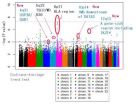(Press-News.org) Physicists at Forschungszentrum Jülich and the universities of Kiel and Hamburg are the first to discover a regular lattice of stable magnetic skyrmions – radial spiral structures made up of atomic-scale spins – on a surface instead of in bulk materials. Such tiny formations could one day form the basis of a new generation of smaller and more efficient data storage units in the field of information technology. The scientists discovered the magnetic spirals, each made up of just 15 atoms, in a one-atomic-layer of iron on iridium. They present their results in the current issue of the scientific journal Nature Physics (DOI: 10.1038/NPHYS2045).
The existence of magnetic skyrmions was already predicted over 20 years ago, but was first proven experimentally in 2009; a group of research scientists from the Technische Universität München (TUM) had identified lattices of magnetic vortices in manganese silicon in a weak magnetic field. Unlike these structures, the ones now discovered by physicists at Jülich, Kiel and Hamburg exist without an external magnetic field and are located on the surface of the materials examined, instead of inside them. Their diameter amounts to just a few atoms, making them at least one order of magnitude smaller than the skyrmions which have been identified to date.
"The magnetically-stable entities that we have discovered behave like particles and arrange themselves like atoms in a two-dimensional lattice", explains Prof. Stefan Blügel, Director at the Peter Grünberg Institute and the Institute for Advanced Simulation in Jülich. "This discovery is for us a dream come true". Already in 2007, the same scientific team had discovered a new type of magnetic order in a thin manganese film on tungsten and demonstrated the critical significance of the so-called Dzyaloshinskii-Moriya interaction for the formation of its wave-like structure. The same interaction is also necessary for the formation of the spiral-shaped skyrmions.
The scientists did not discover the skyrmion lattice at first attempt. Originally, they wanted to prepare a one-atomic layer of chromium on iridium, in order to investigate the presumed existence of a different magnetic state. As the experiments were unsuccessful, they then tried with other metals. Using spin-polarized scanning tunnelling microscopy in studies of iron on iridium at the University of Hamburg, the researchers noticed regular magnetic patterns that were not consistent with the crystalline structure of the metal surface. "We were sure straightaway that we had discovered skyrmions", says Blügel. Intricate calculations undertaken by the Jülich supercomputers subsequently proved him right.
The result is a model describing the formation of the spin alignment through a complex interplay of three interactions: the chiral Dzyaloshinskii-Moriya interaction, the conventional interaction between spins plus a non-linear interaction involving four spins. The model should help, in the future, to selectively influence magnetic structures on surfaces. "We are now planning to investigate the effect of electricity on skyrmions; how do the electron spins of an electric current "ride" the spirals, how do they influence resistance and how are the spirals affected?", says Blügel.
INFORMATION:
Original publication:
Spontaneous atomic-scale magnetic skyrmion lattice in two dimensions;
Stefan Heinze, Kirsten von Bergmann, Matthias Menzel, Jens Brede, André Kubetzka, Roland Wiesendanger, Gustav Bihlmayer, Stefan Blügel;
Nature Physics, published online: 31.07.2011;
DOI: 10.1038/NPHYS2045
Further information:
Forschungszentrum Jülich: http://www.fz-juelich.de/portal/EN/Home/home_node.html
Link to the press release from 10.05.2007 "Supercomputer shows that nanolayers have turning sense" http://www2.fz-juelich.de/portal/index.php?index=163&jahr=2007&cmd=show&mid=480
Research at the Institute "Quantum Theory of Materials": http://www.fz-juelich.de/sid_2C0C0844209B1401BD3B0B651A1E88C0/pgi/pgi-1/EN/Home/home_node.html
Contact:
Prof. Stefan Blügel, Quantum Theory of Materials, Forschungszentrum Jülich, Tel. +49 2461 61-4249, Email: s.bluegel@fz-juelich.de
Press contact:
Angela Wenzik, Science Journalist, Forschungszentrum Jülich, Tel: +49 2461 61-6048, Email: a.wenzik@fz-juelich.de
END
A new national collaboration of asthma genetics researchers has revealed a novel gene associated with the disease in African-Americans, according to a new scientific report.
By pooling data from nine independent research groups looking for genes associated with asthma, the newly-created EVE Consortium identified a novel gene association specific to populations of African descent. In addition, the new study confirmed the significance of four gene associations recently reported by a European asthma genetics study.
The findings, published in Nature Genetics, are a promising ...
In this month's edition of Physics World, Richard Taylor, director of the Materials Science Institute at the University of Oregon, takes a serious, objective look at a topic that critics might claim is beyond scientific understanding – crop circles.
As the global crop-circle phenomenon grows alongside advances in science and technology, Taylor notes how physics and the arts are coming together to produce more impressive and spectacular crop-circle patterns that still manage to maintain their mystery.
Today's crop-circle designs are more complex than ever, with some ...
Scientists on the Norwich Research Park, working with colleagues in China, have developed new techniques that will aid the application of genomics to breeding the improved varieties of crop needed to ensure food security in the future. By dissecting the complicated genome of oilseed rape they have been able to produce maps of the genome that are needed for predictive breeding.
Traditional breeding involves crossing two varieties and selecting the best performing among the progeny. Predictive breeding is a more advanced technique where specific parts of the genome most ...
New York, NY—July 31, 2011—Samuel K. Sia, assistant professor of biomedical engineering at Columbia Engineering, has developed an innovative strategy for an integrated microfluidic-based diagnostic device—in effect, a lab-on-a-chip—that can perform complex laboratory assays, and do so with such simplicity that these tests can be carried out in the most remote regions of the world. In a paper published in Nature Medicine online on July 31, Sia presents the first published field results on how microfluidics—the manipulation of small amounts of fluids—and nanoparticles can ...
Researchers at the RIKEN Center for Genomic Medicine (CGM), together with colleagues at Kyoto University, Tsukuba University, Harvard University, and other medical institutions have identified three new loci associated with susceptibility to adult asthma in the Japanese population. The findings appear in Nature Genetics and derive from a genome-wide study of 4836 Japanese individuals.
Around the world, hundreds of millions of people suffer from bronchial asthma, a chronic inflammatory disease characterized by symptoms of wheezing, shortness of breath and coughing. In ...
How do cells know where to position themselves and where to accumulate in order to carry out their functions correctly within each organ? Researchers with the Colorectal Cancer Lab at IRB Barcelona have revealed the molecular mechanisms responsible for organizing the intestinal epithelium into distinct comportments, defined by frontiers or territories. The study, headed by Eduard Batlle, coordinator of the Oncology Programme at IRB Barcelona and ICREA Research Professor, is published in today's online version of the Journal Nature Cell Biology, part of the prestigious editorial ...
Cold Spring Harbor, NY – A team of scientists at Cold Spring Harbor Laboratory (CSHL) has laid bare the mechanism behind a phenomenon called oncogene addiction in mice suffering from a form of leukemia that mimics acute myelogenous leukemia (AML) in humans. Significantly, the team was able to mobilize their newly gained understanding to target "addiction" pathways in the model mice, resulting in rapid and complete eradication of the cancer, which is usually fatal and resistant to conventional chemotherapy.
Oncogene addiction refers to the curious phenomenon that cancer ...
No-one likes a know-it-all but we expect to be able to catch them out: someone who acts like they know everything but doesn't can always be tripped up with a well-chosen question. Can't they? Not so. New research in quantum physics has shown that a quantum know-it-all could lack information about a subject as a whole, yet answer almost perfectly any question about the subject's parts. The work is published in Physical Review Letters.
"This is something conceptually very weird," says Stephanie Wehner of the Centre for Quantum Technologies at the National University of ...
Seventy per cent of eight-month-old babies have a salt (sodium chloride) intake higher than the recommended UK maximum level, due to being fed salty and processed foods like yeast extract, gravy, baked beans and tinned spaghetti.
Many are also given cows' milk, which has higher levels of salt than breast or formula milk, as their main drink despite recommendations that it should not be used in this way until babies are at least one year old. High levels of salt can damage developing kidneys, give children a taste for salty foods and establish poor eating practices that ...
Alexandria, VA — Tobacco related disease is a primary source of mortality for African American men. Recent studies suggest that "alternative" tobacco products may have supplanted cigarettes as the most common products used by young African Americans, according to new research published in the August 2011 issue of Otolaryngology – Head and Neck Surgery.
While the tobacco-related disease burden is higher in African American adults, prevalence rates of tobacco use among young African American teens are surprisingly lower than those reported for whites. This picture changes ...

